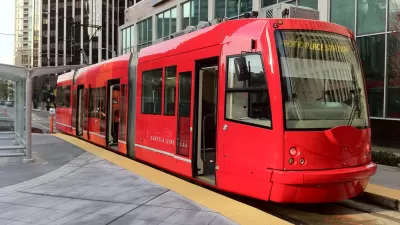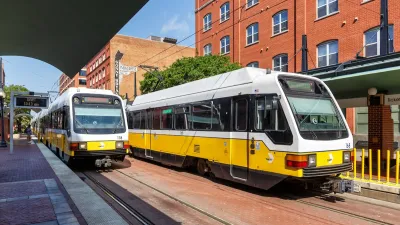It was nearly 50 years ago, when streetcars were seen on the roadways of downtown Washington, DC. Dan Tangherlini, the former transportation director for the District discusses why streetcars matter in the United States capital.
Tangherlini says that one advantage streetcars have over buses is that the tracks "give a sense of permanence, and that encourages long-term investment." Portland, Ore., which started operating North America's first modern streetcar system in 2001, can attest to that. A 2008 study by the city says that since streetcar plans were unveiled in 1997, "$3.5 billion has been invested within two blocks of the streetcar alignment." The study lists "grocery stores, restaurants, galleries, shops and banks" as amenities that have been built near the streetcar lines.
Tangherlini emphasizes that economic development isn't merely a by-product of streetcar lines but, at least in D.C., part of the point of building the streetcar. He says when DDOT was planning the streetcar routes, it first mapped out current and future development, things like office buildings, shops and housing. The city is intentionally using streetcars to connect established activity centers, like Union Station, with emerging ones, like H Street in Northeast, which isn't connected to a Metrorail line but is trying to sustain new businesses and attract more visitors. Transportation isn't just for getting around, "it's for making places for people to go," says Tangherlini.
Thanks to Garrett Bradford
FULL STORY: The Case for Streetcars

Alabama: Trump Terminates Settlements for Black Communities Harmed By Raw Sewage
Trump deemed the landmark civil rights agreement “illegal DEI and environmental justice policy.”

Planetizen Federal Action Tracker
A weekly monitor of how Trump’s orders and actions are impacting planners and planning in America.

Why Should We Subsidize Public Transportation?
Many public transit agencies face financial stress due to rising costs, declining fare revenue, and declining subsidies. Transit advocates must provide a strong business case for increasing public transit funding.

Understanding Road Diets
An explainer from Momentum highlights the advantages of reducing vehicle lanes in favor of more bike, transit, and pedestrian infrastructure.

New California Law Regulates Warehouse Pollution
A new law tightens building and emissions regulations for large distribution warehouses to mitigate air pollution and traffic in surrounding communities.

Phoenix Announces Opening Date for Light Rail Extension
The South Central extension will connect South Phoenix to downtown and other major hubs starting on June 7.
Urban Design for Planners 1: Software Tools
This six-course series explores essential urban design concepts using open source software and equips planners with the tools they need to participate fully in the urban design process.
Planning for Universal Design
Learn the tools for implementing Universal Design in planning regulations.
Caltrans
Smith Gee Studio
Institute for Housing and Urban Development Studies (IHS)
City of Grandview
Harvard GSD Executive Education
Toledo-Lucas County Plan Commissions
Salt Lake City
NYU Wagner Graduate School of Public Service





























